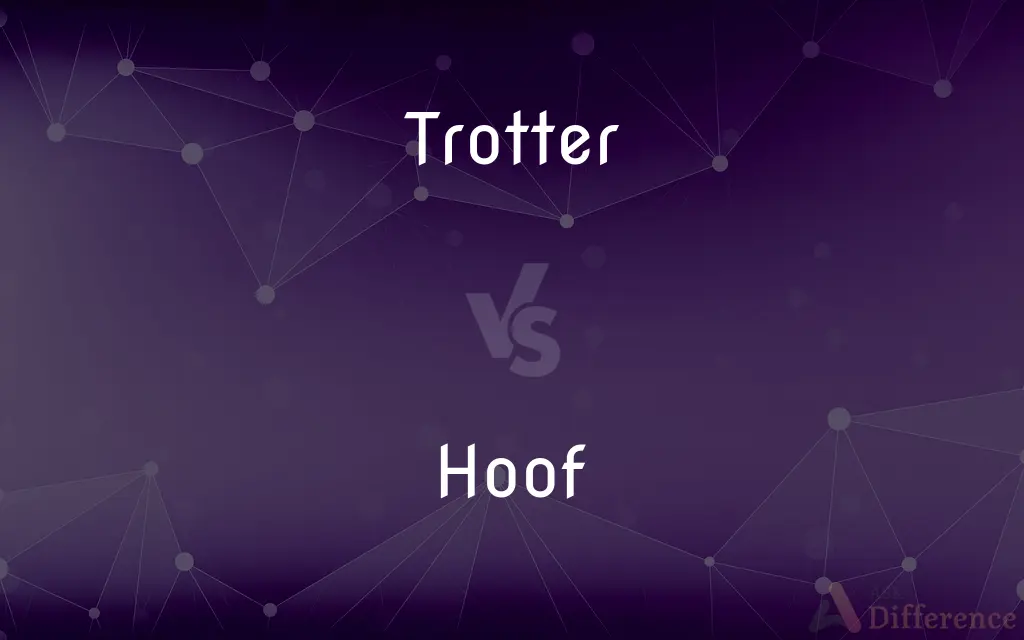Trotter vs. Hoof — What's the Difference?
By Fiza Rafique & Urooj Arif — Updated on March 19, 2024
A trotter is a term for the foot of a pig, often used in cooking, whereas a hoof is the hard foot of certain animals like horses, cows, and deer, providing support and protection.

Difference Between Trotter and Hoof
Table of Contents
ADVERTISEMENT
Key Differences
A trotter, specifically referring to the culinary use of a pig's foot, is a delicacy in various cuisines around the world. It is known for its gelatinous texture after long cooking. On the other hand, a hoof refers to the hard, outer covering of the feet of certain mammals like horses and cows, serving a critical role in their mobility and health.
Trotters are often slow-cooked in stews and soups to extract their flavor and gelatin, making dishes rich and hearty. Whereas hooves, beyond their biological function, are sometimes used in making glue or gelatin but are not commonly eaten.
In terms of care, trotters require thorough cleaning and preparation before they are cooked, including removal of hairs and sometimes blanching. Hooves, conversely, need regular maintenance for the well-being of the animal, including trimming and, in some cases, the fitting of horseshoes.
Nutritionally, trotters are high in collagen and can be a source of protein, though they are also rich in fat. Hooves, while not consumed, are made of keratin, a protein that's not digestible by humans.
Trotters are celebrated in cuisines such as Chinese, Korean, and Italian, highlighting the diverse culinary practices around the world. Hooves, while not a food product, are integral to many forms of traditional and modern transport, work, and equestrian sports, underscoring their importance in human society.
ADVERTISEMENT
Comparison Chart
Definition
The foot of a pig, used in cooking.
The hard protective covering of the feet of certain animals.
Primary Use
Culinary, especially in soups and stews.
Provides support and protection for the animal’s feet.
Preparation
Cleaning, sometimes blanching, before cooking.
Regular maintenance including trimming and horseshoe fitting.
Nutritional Content
High in collagen and fat.
Not typically consumed, made of keratin.
Cultural Significance
Featured in various global cuisines as a delicacy.
Essential in animal-based transport and sports.
Compare with Definitions
Trotter
Often featured in international cuisines.
Trotter dishes are a staple in many Korean celebrations.
Hoof
Not consumed in cuisine.
Unlike trotters, hooves are not considered edible.
Trotter
Known for its gelatinous texture when cooked.
Trotters are essential for adding richness to traditional broths.
Hoof
Made of keratin.
The hoof's toughness comes from keratin, similar to human fingernails.
Trotter
Requires thorough cleaning before use.
Preparing trotters begins with a meticulous cleaning process.
Hoof
Integral to animal mobility.
Healthy hooves are crucial for a deer's swift movement in the forest.
Trotter
A pig's foot used in cooking.
The chef prepared a savory trotter stew that simmered for hours.
Hoof
Requires regular maintenance.
Regular hoof trimming is essential for the horse's well-being.
Trotter
A source of collagen.
Trotters are prized for their high collagen content, beneficial for skin health.
Hoof
(informal) To dance, especially as a professional.
Trotter
A horse that trots, especially one trained for harness racing.
Hoof
The hard foot of certain animals like horses.
The horse's hooves clattered loudly on the cobblestone.
Trotter
(Informal) A foot, especially the foot of a pig or sheep prepared as food.
Hoof
A hoof ( or ), plural hooves ( or ) or hoofs , is the tip of a toe of an ungulate mammal, strengthened by a thick and horny keratin covering.Artiodactyls are even-toed ungulates, meaning that these species have an even number of digits on each foot. Ruminants, with two main digits, are the largest group.
Trotter
One who trots.
Hoof
The horny sheath covering the toes or lower part of the foot of a mammal of the orders Perissodactyla and Artiodactyla, such as a horse, ox, or deer.
Trotter
In harness racing, a horse with a gait in which the front and back legs on opposite sides take a step together alternating with the other set of opposite legs; as opposed to a pacer.
Hoof
The foot of such an animal, especially a horse.
Trotter
The foot of a pig, sheep, or other quadruped, especially when prepared as meat#Noun.
Grange cookbook recipes for trotters
Hoof
(Slang)The human foot.
Trotter
(slang) A person's foot.
Hoof
To trample with the hooves.
Trotter
A tailor's assistant who goes around to receive orders.
Hoof
To dance, especially as a professional.
Trotter
One that trots; especially, a horse trained to be driven in trotting matches.
Hoof
To go on foot; walk.
Trotter
The foot of an animal, especially that of a sheep; also, humorously, the human foot.
Hoof
The tip of a toe of an ungulate such as a horse, ox or deer, strengthened by a thick keratin covering.
Trotter
Foot of a pig or sheep especially one used as food
Hoof
(slang) The human foot.
Get your hooves off me!
Trotter
A horse trained to trot; especially a horse trained for harness racing
Hoof
An ungula.
Hoof
To trample with hooves.
Hoof
(colloquial) To walk.
Hoof
To kick, especially to kick a football a long way downfield with little accuracy.
Hoof
The horny substance or case that covers or terminates the feet of certain animals, as horses, oxen, etc.
On burnished hooves his war horse trode.
Hoof
A hoofed animal; a beast.
Our cattle also shall go with us; there shall not a hoof be left behind.
Hoof
See Ungula.
Hoof
To walk as cattle.
Hoof
To be on a tramp; to foot.
Hoof
The foot of an ungulate mammal
Hoof
The horny covering of the end of the foot in hoofed mammals
Hoof
Walk;
Let's hoof it to the disco
Hoof
Dance in a professional capacity
Common Curiosities
What is a trotter?
A trotter is the foot of a pig, often used in cooking for its flavor and gelatinous texture.
How are trotters prepared for cooking?
Trotters are cleaned, sometimes blanched, and then cooked slowly to extract their flavor and gelatin.
Are trotters nutritious?
Trotters are rich in collagen and fat, making them both a flavorful and nutritious addition to dishes.
Are trotters eaten in all cultures?
While not universally consumed, trotters are considered a delicacy in many cultures around the world.
Do trotters and hooves taste the same?
Since hooves are not consumed and trotters have a distinct taste from slow cooking, they do not taste the same.
What is a hoof?
A hoof is the hard protective covering of the feet of certain animals, such as horses and cows, made of keratin.
Can you eat a hoof?
Hooves are not typically consumed due to their tough keratin composition.
What maintenance do hooves require?
Hooves need regular trimming and sometimes the fitting of horseshoes to maintain the animal's health and mobility.
What is the primary difference between a trotter and a hoof?
The primary difference is in their use; trotters are used in cooking, while hooves are part of an animal's body essential for its mobility.
Why do hooves need regular maintenance?
Regular maintenance ensures the health and well-being of the animal, preventing issues that could impair mobility.
How does the preparation of trotters differ from that of other meats?
The preparation of trotters includes specific cleaning processes and slow cooking to break down the gelatinous tissues, unlike many other meats.
What are the cultural significances of trotters?
Trotters are celebrated in various cuisines globally, reflecting diverse culinary traditions and practices.
How do hooves contribute to animal health?
Healthy hooves are crucial for an animal's mobility, affecting its ability to walk, run, and engage in daily activities.
Why are trotters considered a delicacy?
Trotters are valued for their unique texture and the rich, gelatinous quality they add to dishes.
Can trotters be eaten raw?
Trotters need to be cooked thoroughly due to safety concerns and to achieve the desired texture.
Share Your Discovery

Previous Comparison
Apronym vs. Acronym
Next Comparison
Milk vs. SilkAuthor Spotlight
Written by
Fiza RafiqueFiza Rafique is a skilled content writer at AskDifference.com, where she meticulously refines and enhances written pieces. Drawing from her vast editorial expertise, Fiza ensures clarity, accuracy, and precision in every article. Passionate about language, she continually seeks to elevate the quality of content for readers worldwide.
Co-written by
Urooj ArifUrooj is a skilled content writer at Ask Difference, known for her exceptional ability to simplify complex topics into engaging and informative content. With a passion for research and a flair for clear, concise writing, she consistently delivers articles that resonate with our diverse audience.














































